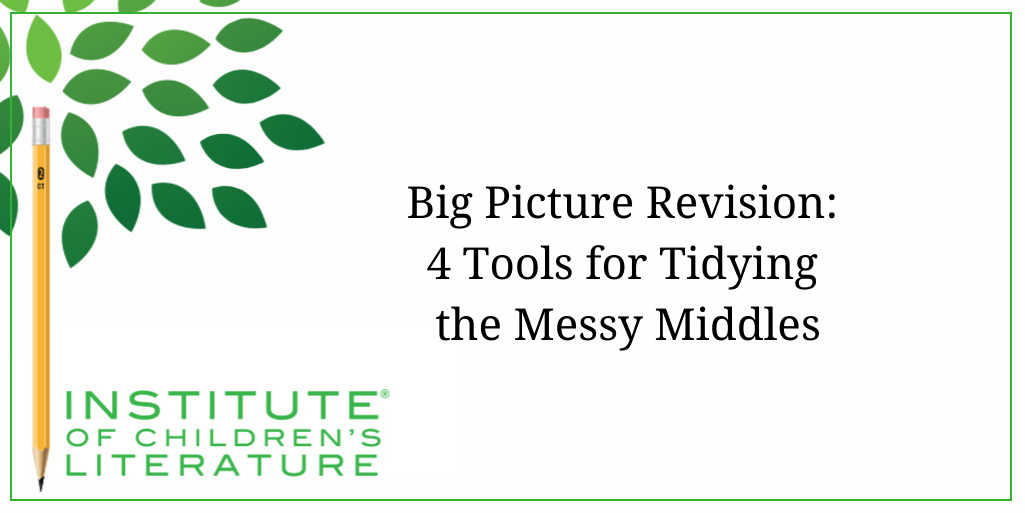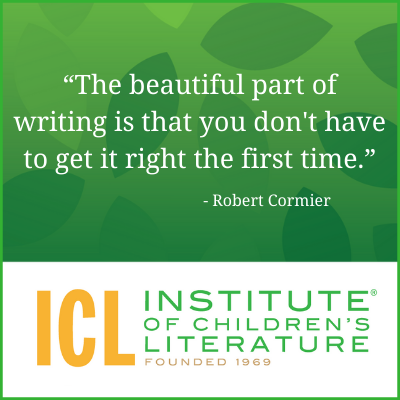
5 Ways Writers Can Prep for 2025 Goal Setting
Before we roll on to the new writing year, let’s harness our optimism for the blank slate before us and prepare for our 2025 Goal Setting just for writers.

We teach our students how to write and get published!
View our Course Catalog >
When writing for children, one of the toughest parts of any piece to write is the middle. Perhaps you’re unsure if the pace is dragging, or if you somehow lost track of some of the plot pieces you’re juggling. Middles can be scary and they are a common place where writers simply abandon ship, never to finish. Because of this, it’s not surprising that middles can be a special problem in the revision process as well. Middles are where questions can be raised that are never answered and readers can become confused and frustrated. Approaching the revision process for the middle of your book benefits from certain tools. Let’s look at four revision tools.
One of the most valuable things you can do when revising the middle of a story, article, or book is to create an outline for your work after you’ve done the writing. I outline all my books before I write them, but I know many writers don’t. They write as the story comes to them. Organic, spontaneous writers may use this approach for fiction and nonfiction. There is nothing wrong with writing in this kind of spontaneous manner, as long as structure and organization are cleaned up during revision. Outlines can help you do that. I’ve run across plenty of nonfiction articles that would have benefitted from the writer outlining either before or after the writing to see structural problems in the work.

Outlines help reveal issues with pacing and flow by showing how much of the plot is being spent with each element. Long, dragging areas become obvious when you notice they’re taking up far too much of the overall story. In novels, these revision outlines can be done as chapter-by-chapter synopses or as scene-by-scene synopses that show who was in the scene and what happened in the scene: who was there? What did they say? What did they do? What action did they take?
In a scene-by-scene outline, overuse of exposition will show itself when you find all the things you’ve written that weren’t part of the story’s scenes at all. Scene outlines work as well for short stories as they do for novels. With picture books, you may wish for a simpler outline divided by beginning/middle/end—noting what happens in each section. When a story or article is easy to outline, that’s a sign that the organization is strong and clear. When it’s difficult to outline, that will show you where to focus your revision to result in a story with a clearer organization, structure, and flow.
For fiction and narrative nonfiction, another useful tool is a timeline. It allows you to make sure the chronology of your story works and that you aren’t creating confusion for the reader about what happened when. When creating the timeline for the story, you’ll benefit from noting which page (or range of pages) of the manuscript is dedicated to each element of the timeline. For instance, if it’s important to know that the main character’s parents are dead but that happens before the beginning of the book, it will still be on the timeline. I tag such events that are outside the scope of the book but essential to the characters with a special notation letting me know where this was revealed in the story.
From timelines and reveal notes, I notice problems with over-telling. For instance, I might know it is very important that we know the main character’s parents are dead, and that might lead me to tell the reader about it far too many times. As I’m noting these reveals, I can decide which reveals are essential and which are simply redundant. I can also see if my chronology in the book is confusing.
Another revision tool I use regularly when writing novels is a question sheet. This works a lot like an outline. As I read through the book, article, or story, I note every question that I imagine popping up in the mind of the reader. For instance, if I say, “Miranda’s fears were many and varied.” Then the questions that pop up are “What is Miranda afraid of? Why does she have so many fears? How will her fears impact the story in a meaningful way?” I note where the question popped up, then as I continue reading, if I spot an answer to any of the questions, I jot a note of where it happened. Then when I’ve gone through the whole piece, I look for questions that were never answered. Those I go back and answer somewhere, or else I think deeply about why the question might not need an answer at all.
Sometimes the question isn’t answered directly, but I believe the reader will be able to imagine an answer that will satisfy without my having to write in a specific answer. Sometimes this assumption doesn’t work for an editor, and I ultimately get editor feedback that I need to reveal the answer more clearly. But with the question sheet, I rarely end up with questions from an editor that I never even considered. And I rarely end up confusing the reader too much.
These question sheets also point me toward things that seemed like a good idea as I was writing, but never really went anywhere. Those can be removed entirely from the manuscript (unless I want to undertake the larger revision of transforming these stray bits into something important. I rarely want to do that.)
I’m the first to admit I don’t print out novels. I’m way too cheap for that, though I realize I’d be well-served if I did. Still, I do print out short stories, articles, children’s chapter books, and the like. Anything I can do to make what I have written look different helps me to view the writing with fresh eyes and to see problems I would have overlooked a hundred times if I’d stuck with its original format on the screen. Quite simply, printing out your manuscript helps to give you the distance and objectivity you’ll need for a good revision.
One of the benefits of printing your manuscript is that you can write on it. You can also color on it. For example, for a nonfiction article, I often use a variety of different colored highlighters to make my main facts jump out and my supporting facts clear. This tends to give me a visual sign of extraneous information that is neither a main fact nor a supporting fact. These kinds of unrelated blobs of info can muddle my organizational structure, so spotting them helps me revise to make the piece stronger. In nonfiction articles, I also use separate colors for the introductory hook, and for the sentence that reveals what the reader can expect from the article. Sometimes I also mark humor, wordplay, and the like.
In fiction manuscripts, I use color to note exposition (where I’m simply telling the reader something necessary), dialogue, and action. I’ll underline verbs and circle character names (since overuse of character names is one of the things editors often see in manuscripts). All these things help to give me a visual picture of the way the story has come together. It lets me see if I’ve overused one element and overlooked the need for something else.
Printed revision gives you permission to be messy. You can note things you want to fix, questions you want to check on, and even places where you may want to move a scene to a different spot. Anything goes in a printed revision and that freedom can help you spot problems that you may have missed in the story when it was on the screen.
I don’t always use all four of these revision tools for every time, but I’ve learned the value of them for making the strongest writing I can manage, so I’ll use at least one of them every time. Strong revisions lead to better stories, articles, and books. And that leads to more acceptances. So, consider adding these tools to your revision toolkit. Give them a try. The results may surprise you.
With over 100 books in publication, Jan Fields writes both chapter books for children and mystery novels for adults. She’s also known for a variety of experiences teaching writing, from one session SCBWI events to lengthier Highlights Foundation workshops to these blog posts for the Institute of Children’s Literature. As a former ICL instructor, Jan enjoys equipping writers for success in whatever way she can.

Before we roll on to the new writing year, let’s harness our optimism for the blank slate before us and prepare for our 2025 Goal Setting just for writers.

Writers can be thin-skinned when it comes to getting feedback on their work. Let’s look at 4 ways to positively deal with constructive criticism!

Rejection is part of the territory when it comes to being a writer. Today we offer reflection for writers to help redirect your efforts after a rejection.
1000 N. West Street #1200, Wilmington, DE 19801
© 2024 Direct Learning Systems, Inc. All rights reserved.
1000 N. West Street #1200, Wilmington, DE 19801
© 2024 Direct Learning Systems, Inc. All rights reserved.
1000 N. West Street #1200, Wilmington, DE 19801
© 2024 Direct Learning Systems, Inc. All rights reserved.
1000 N. West Street #1200, Wilmington, DE 19801
© 2024 Direct Learning Systems, Inc. All rights reserved.

1000 N. West Street #1200, Wilmington, DE 19801
© 2025 Direct Learning Systems, Inc. All rights reserved.

1000 N. West Street #1200, Wilmington, DE 19801
©2025 Direct Learning Systems, Inc. All rights reserved. Privacy Policy.
3 Comments